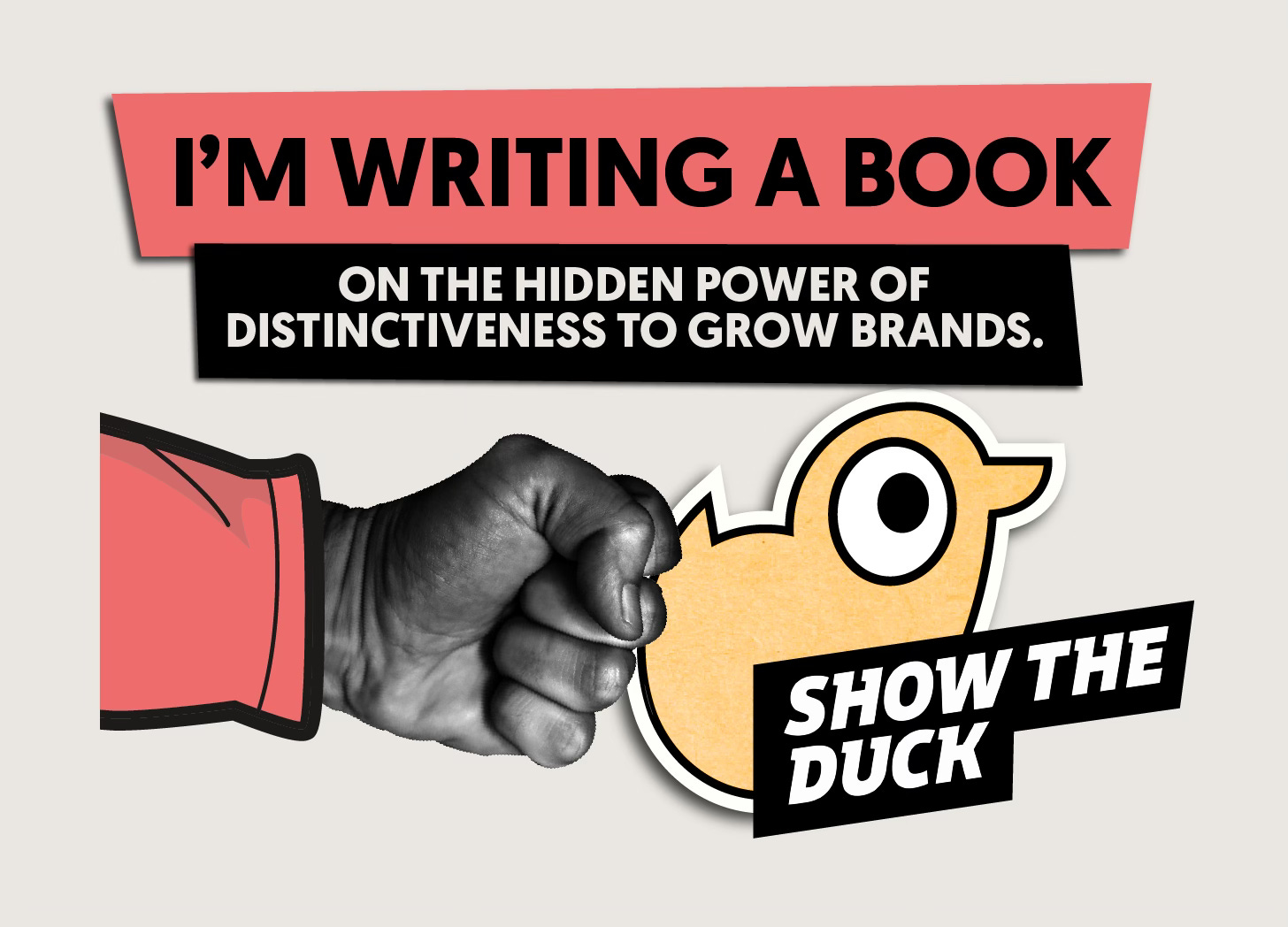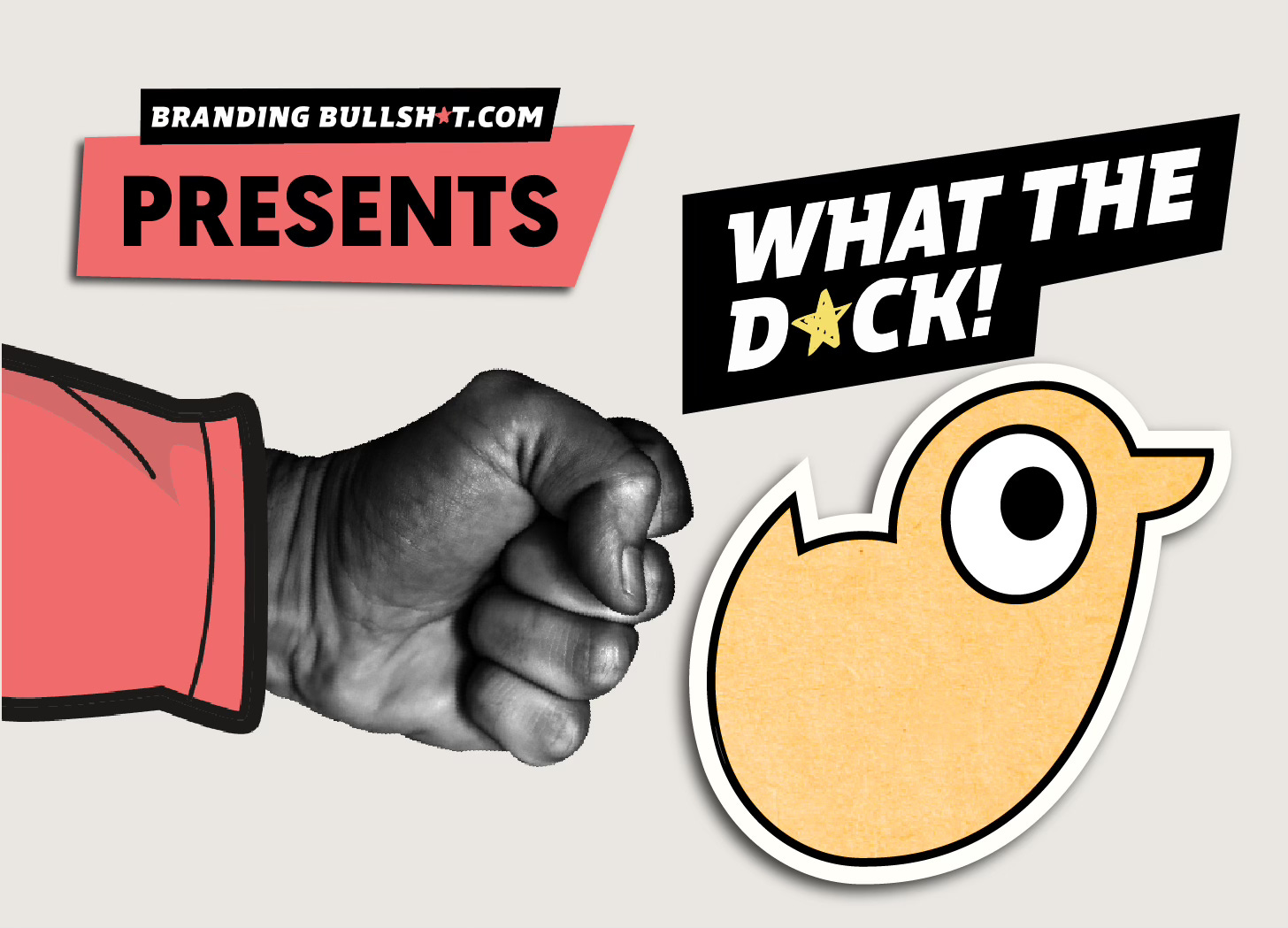I’m Writing a Book: Show The Duck—The Hidden Power of Distinctiveness to Grow Brands
Here's a sneak peek.
I'm writing a book.
With my ADHD, telling people is the best way to ensure I actually finish it. So now you know: for the past couple of months, I've been working on a book, and I'm ready to share some early thoughts to get your feedback.
It's titled Show The Duck: The Hidden Power of Distinctiveness To Grow Brands.
Many assume “standing out” is a given. Most designers nod along to the idea of distinctiveness, yet we’re seeing less and less of it. There are plenty of reasons—“brand strategy theater” being the biggest—but the point is this: marketers, business owners, and designers need a reminder of what distinctiveness actually does for a brand.
This book is my attempt to restate what’s often taken for granted—to keep distinctiveness at the center of brand creation and growth, guided by what we know from marketing, advertising, behavioral, and memory science. Whether you’re naming your new business or designing for someone else’s, Show The Duck will be a reminder of why distinctiveness matters—and how to use it to grow a brand.
Here's a sneak peek at the introduction to the first chapter. I hope the world needs this book and that I see it through to the end. I may share more excerpts as I write.
An Excerpt From Show The Duck
Modern Branding Began With a Pig and a King.
Before 1916, grocery shopping was simple: shoppers handed a list to a clerk behind the counter who fetched each item. Brands like Quaker Oats or Coca-Cola were known only because of early advertising, but most goods weren’t even packaged—flour, sugar, and pickles were sold loose from barrels or bins. Brand recognition mattered little; trust was placed in the grocer, not the label.
Piggly Wiggly was about to change that.
The Pig
Piggly Wiggly was founded in 1916 by Clarence Saunders in Memphis, Tennessee. Saunders’ connection to groceries began early: at age nine, he worked holiday shifts at a local general store, cleaning and oiling kerosene lamps. By 14, he left school to work full-time, learning every corner of the business firsthand. At 19, he moved into grocery wholesaling, gaining deeper industry insight. By age 35, Saunders had a groundbreaking idea that would forever change the future of branding and retail.
By moving products from behind the counter onto open aisles, Saunders eliminated the need for most clerks, cutting labor costs and giving customers the freedom to browse and choose for themselves. Suddenly, brands were face-to-face with customers. Where once a friendly clerk stood between them—recommending products and guiding choices—now the brands had to earn trust on their own.
The King
Two decades after the first Piggly Wiggly, another visionary, Michael J. Cullen, built on Saunders’ innovation to create King Kullen, widely considered America’s first true supermarket.
In 1930s Queens, a grocery store boasting 6,000 square feet of shelf space—about half the size of a typical Walgreens today—opened its doors. Thousands lined up to experience it. Inside, shoppers were overwhelmed; some even fainted. Sixteen years later, when a similar store opened in Rome, a woman was seen running up and down the aisles, exclaiming, “It must be heaven! There are mountains of food!”
Today, shoppers navigate nearly infinite choices—the average supermarket stocks 50,000 products. Back in 1930s Queens, King Kullen’s mere 1,000 items felt like a “mountain of food.” Nobody could imagine a grocery store that big—except Michael Cullen, who had envisioned it more than 15 years before opening King Kullen.
Like Clarence Saunders, Cullen started young. He entered the grocery business at 18, sparking a lifelong passion that would reshape retail. By the time he married in 1913, he was already railing about his revolutionary supermarket idea. No one listened. Undeterred, he nurtured the dream for nearly two decades. Finally, in 1930, while a Kroger branch manager, he put it into writing—a formal letter to the company’s Vice President outlining the supermarket that would change retail.
In the letter, Cullen didn’t hold back. He promised Kroger he had an idea that would make them “the greatest chain grocery store on the face of the earth.” He said his plan would lead people out of “bondage” and into “the promised land.” He even predicted—correctly—that he “would have to call out the police, and let the public in so many at a time.”
For any doubters, Cullen had a ready retort: “Nobody ever flew the Atlantic either—until Lindbergh did it.”
And then…silence.
Cullen waited for a reply that never came. He didn’t know his letter had been misplaced by a subordinate, lost before it ever reached the VP’s desk. To Cullen, it looked like rejection.
So he did what people with unshakable confidence do: He walked away and built the future himself. That same year, Cullen opened King Kullen: the world’s first true supermarket. It was an instant success.
Distinctiveness is Now King.
A pig and a king set the stage for a shift that would fundamentally change how brands capture attention in a crowded market.
For over a century after the Piggly Wiggly and King Kullen, brands have grappled with a singular, crucial question: In a world overflowing with choice, what compels a shopper to select your brand over others?
The answers arrived in waves, each building upon its predecessor, but none encompassing the complete truth. In the 1960s, Rosser Reeves championed the Unique Selling Proposition—that singular, defensible claim distinguishing a brand. Later, in the 1970s and 1980s, marketing theorists Aaker and Keller directed our focus to brand equity: the intricate web of associations, perceptions, and loyalty. The 1990s saw Seth Godin highlight permission marketing and the pull of tribes, while in 2009, Simon Sinek urged brands to “start with why” and define a deeper purpose.
Each of these theories illuminated varying degrees of consumer behavior. However, beneath the surface of these compelling ideas, a more fundamental truth awaited discovery.
In 2010, marketing scientist Byron Sharp, director of the Ehrenberg-Bass Institute, ignited fierce debate in the branding world with his book How Brands Grow. He challenged long-held beliefs about loyalty, differentiation, targeting, and emotional connection. Not all of Sharp’s ideas are widely accepted today. But amid the controversy, one insight has gained near-universal agreement among marketers: distinctiveness grows brands. Brands that look and feel unmistakably themselves—consistently and repeatedly—are more likely to be remembered, recognized, and bought.
For those outside of the inner circle of marketing, distinctiveness is not differentiation.
Differentiation, Reeves argued, is about what you offer—a safer car, a greener sweater, a more durable widget. Distinctiveness is less about what you offer; it’s about the cues—colors, shapes, sounds—that make people recognize your brand instantly, whether on a shelf or in an ad.
While “standing out” has always felt like marketing 101, what’s often missed is how ridiculously powerful it can be on its own. Think of McDonald’s golden arches, glowing from half a mile away. The Geico Gecko—charming or annoying, you still remember him. Nike’s Just Do It. Intel’s little chime. These aren’t just brand identifiers. They’re memory hacks—built to stick, and over time, to quietly steer you toward one brand over another.
Brand recognition matters more than most marketers want to admit. People don’t analyze every purchase. They don’t fall in love with your brand story or get misty-eyed over your mission statement. Most choices happen on autopilot.
Behavioral science—and decades of real-world data from the Ehrenberg-Bass Institute and others—shows what’s really going on: when attention is low, people default to what they’ve seen before. The brands that show up in memory—even faintly—have the edge. Those little bits of branding are not just helping people recognize you. They’re helping them choose you, whether they realize it or not.
And yet, talk of distinctiveness rarely escapes marketing departments or academic papers. Differentiation has gone mainstream; distinctiveness is still stuck inside marketing. This book breaks that bubble.
It argues that distinctiveness is the foundation for growth in any brand—new or established, global or local, consumer or business-facing. A distinctive identity only works when it’s carried through everything a brand does—every ad, every package, every touchpoint. Recognition doesn’t come from a single moment of creativity but from showing up the same way, again and again, until the brand becomes impossible to miss.
Whether you are a small business owner navigating your market, a designer crafting visual identities, or a marketer at any level, this book will provide a new lens for many through which to view branding.
First, I will explain why distinctiveness matters, drawing insights from marketing science, behavioral science, memory theory, and compelling real-world examples.
Next, we’ll unearth the well-intentioned forces that stand in the way of distinctiveness. We’ll expose the popular myths and common beliefs—the “orthodoxies” of branding—that have quietly, almost imperceptibly, diverted brands from a core strategy they so desperately need. We’ll shine a light on how these well-intentioned but misguided ideas have, for decades, led brands astray.
Finally, I will outline a straightforward, practical approach for creating and building upon a distinctive brand from the ground up. This includes guidance on choosing names, designing logos or brand characters, picking a color scheme, and developing other brand assets that genuinely work in your favor. Many small business owners, understandably, treat their brand as a personal endeavor, selecting names and visuals that hold deep personal meaning. Others default to industry conventions—such as incorporating a spine into a chiropractor’s logo—believing that clear communication of what they do is paramount.
However, standing out often conflicts with deep meaning or perfect clarity. The goal isn’t to make people understand you—it’s to make them remember you. We’ll explore how breaking from your category’s patterns—whether it’s obvious clichés like scales in a law firm logo or subtler defaults like “handcrafted” logos and earth tones in organic food branding—can become the quiet but powerful edge your brand needs.
That’s what this book calls the duck—the name or branding element that might feel random, even out of place, but becomes a hack for memorability and recognition. Every brand needs its duck.
Ultimately, this book distills down to one essential objective: to be remembered. Because in a world saturated with options, distinctiveness is no longer an advantage—it’s a condition for survival. The story began with a pig and a king. Now it continues with a duck.
Enjoyed that? Unlock What The Duck!—Wild Branding Histories of Famous Names & Assets with a Paid Subscription
My book, Show The Duck will use a handful of origin stories—the Aflac Duck, Domino’s, SurveyMonkey’s name-change fiasco, and more—to illustrate the power of distinctiveness. Someday, I hope to compile 50 of these stories into a separate book devoted entirely to origin stories.
In the meantime, you can upgrade your Branding Bullsh*t subscription to access many of these stories through a paid series I’m calling What The Duck!—$6/month or $60/year.




